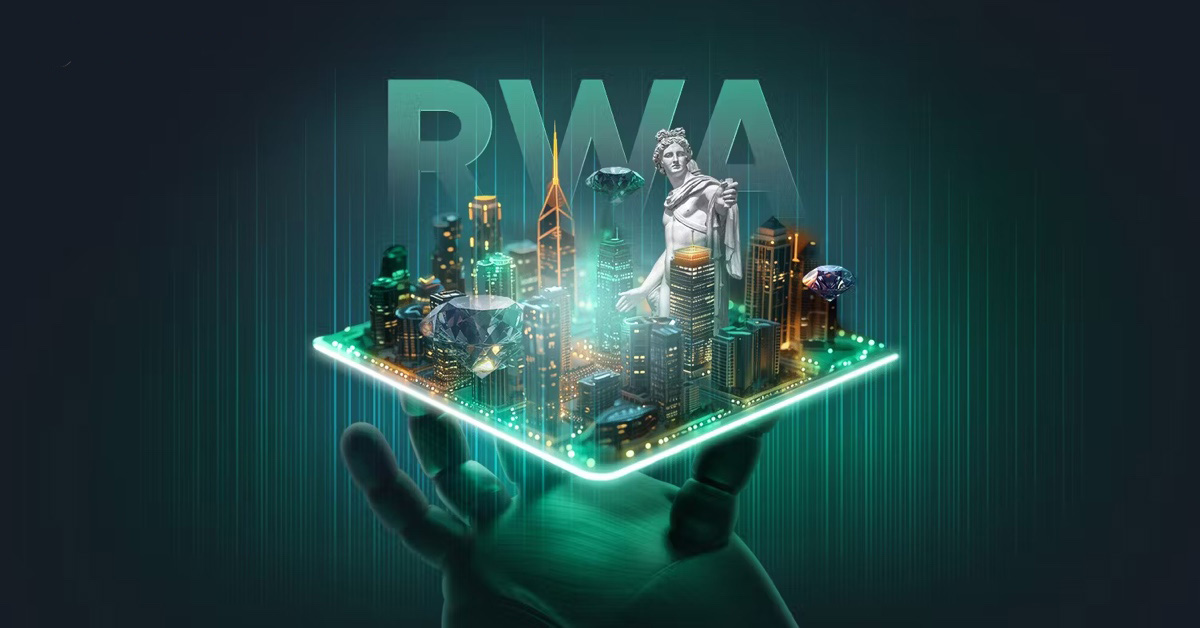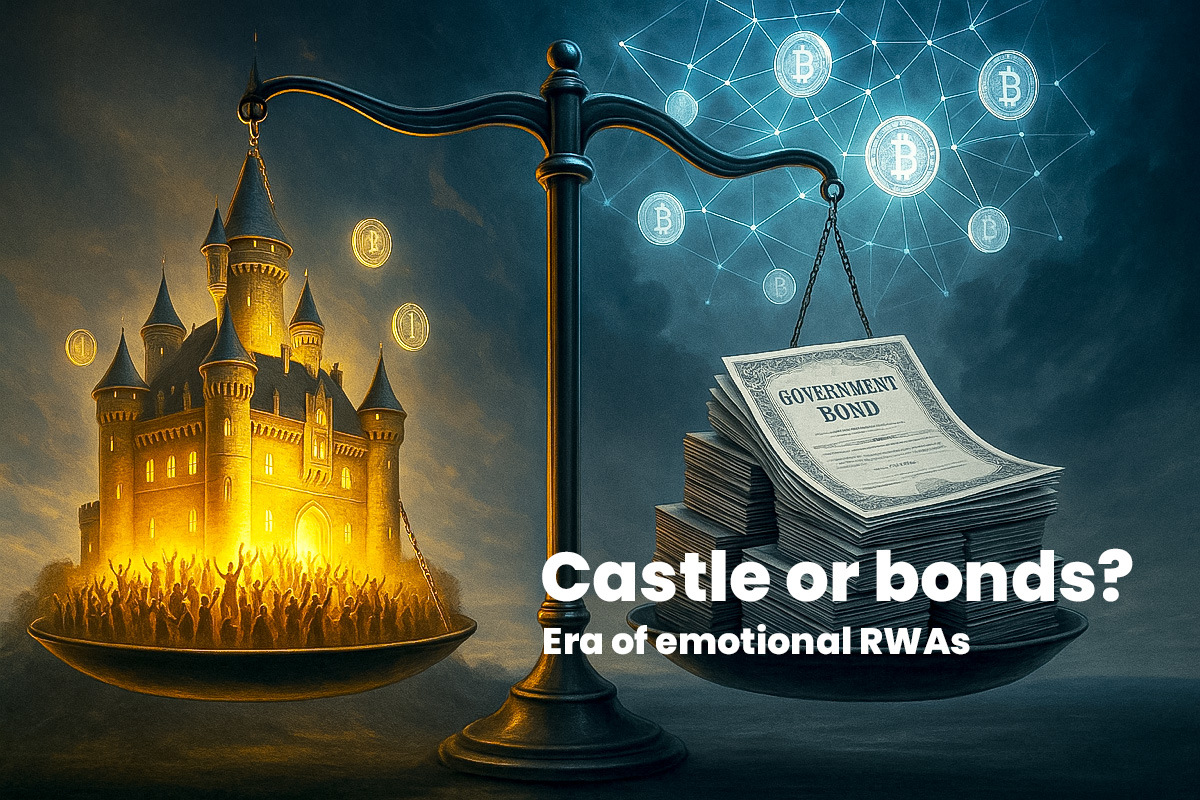Would you rather own a slice of a treasury bill – or a share of a castle that doubles as a Web3 learning hub?
That is the question every serious investor in tokenisation will soon face.
Right now, Real World Assets (RWAs) are the hottest new frontier in blockchain. Analysts from Boston Consulting Group predict that tokenisation could become a $16 trillion market by 2030. BlackRock’s CEO Larry Fink calls it “the next generation for markets.” Franklin Templeton already has hundreds of millions in tokenised assets under management. Binance, Coinbase, and major exchanges are racing to list RWA tokens.
But if you look closer at what is being tokenised today, you may feel the same thing many investors secretly admit: it’s dull. Bonds. Treasury bills. Invoices. Commercial real estate portfolios.
Yes, these assets are safe. Yes, they provide yield. But they are not the kind of assets that capture imagination. Nobody brags to their friends about owning a fraction of a government bond. Nobody builds a community around a token tied to invoice financing.
That is why the next big wave of RWAs will not be about numbers. It will be about meaning.
Why the First Wave Is Boring
Let’s be fair. The first wave of RWAs had to be boring. Regulators like it that way. Bonds and treasuries are safe. They prove the model works. They provide liquidity. They make tokenisation credible in the eyes of institutions.
But here is the problem: they are commodities. A tokenised treasury bill looks almost identical no matter who issues it. Tokenised debt is just another form of yield. There is no brand, no story, no differentiation.
Investors will not stop at safe yields. Once the infrastructure is proven, they will look for assets that deliver more than numbers. Assets that carry emotion, prestige, scarcity, and community.
And that is where cultural RWAs come in.
The Rise of Emotional Assets
History shows us that investors always move from safe to exciting.

First, they put money into bonds. Then into equities. Then into art, wine, classic cars, rare watches, luxury real estate. Not because these are safer, but because they are scarce, beautiful, and meaningful.
Tokenisation simply accelerates this shift. Once you can buy a fraction of anything, why would you stop at debt? Why not buy a fraction of a vineyard in Bordeaux, a villa in Tuscany, or a castle in Eastern Europe? Why not co-own a piece of cultural heritage or a landmark with real-world revenue streams?
These are assets people talk about. Assets that make headlines. Assets that turn ownership into pride, not just profit.
And in markets, pride often outperforms yield.
The Playbook for Cultural RWAs
So how do cultural RWAs work? The playbook is surprisingly clear:
- Scarcity. There are thousands of bonds, but only so many castles, vineyards, or historic villas. Scarcity creates long-term value.
- Emotional resonance. Investors want assets that feel alive. Owning a piece of history, culture, or luxury lifestyle is far more attractive than holding anonymous debt.
- Multiple revenue streams. Unlike a bond with fixed yield, cultural assets generate diverse income: rent, events, memberships, tourism, digital experiences.
- Community magnetism. People do not gather around a bond. They do gather around a castle, a winery, or a cultural landmark. Tokenisation makes them co-owners and community members at once.
- Brand value. A cultural asset carries its own brand – one rooted in history and story. That brand multiplies the financial value of the asset.
In short: cultural RWAs are not only assets. They are experiences. And experiences scale differently.
Why Cultural RWAs Can Outperform Bonds
Let’s be blunt. A tokenised bond will never 10x. A castle, a vineyard, or a heritage landmark might. Why?
- Scarcity premium. Government debt is infinite. Castles are not. Scarcity drives appreciation.
- Tourism and lifestyle boom. Global tourism is projected to reach $15 trillion by 2033. Heritage and luxury sites are natural beneficiaries.
- Hybrid models. A cultural RWA is not just an investment. It is a lifestyle membership, an exclusive community, a brand. That hybrid identity makes it more resilient.
- Story-driven value. People invest in stories as much as in numbers. “I own part of a historic castle” is a story. “I own a bond” is not.
Numbers may attract money. But stories attract both money and people. That is why cultural RWAs can outperform bonds in both ROI and impact.
From Dry Yield to Living Assets
Think of it this way.
A bond pays you yield. A castle pays you yield, plus memories, prestige, and meaning.
A bond is invisible. A cultural RWA is Instagrammable.
A bond gives you a percentage. A vineyard gives you bottles of wine with your name on the label.
This is the real competitive edge of cultural RWAs. They create emotional dividends. Investors not only get returns – they get pride, joy, belonging. And emotional dividends make people hold longer, promote louder, and invest deeper.
The Cultural RWA Market Is Undervalued
Right now, almost all attention in tokenisation is on bonds and funds. That makes cultural RWAs massively undervalued.
But the demand is clear. Every luxury industry shows it. The global art market is worth $67 billion. The fine wine market has outperformed the S&P 500 over 20 years. Collectibles like watches, sneakers, and NFTs show people crave scarcity + story.
Tokenisation simply unlocks those markets for everyone, not just the ultra-rich.
The first projects that build credible, revenue-generating cultural RWAs will capture enormous upside. They will not only ride the tokenisation wave. They will define it.
What This Means for Investors
For investors, cultural RWAs offer a portfolio strategy no bond can match:
- Yield + Emotion. Secure income streams plus emotional dividends.
- Diversification. A hedge against purely financial RWAs.
- Community growth. The more owners, the stronger the brand and demand.
- Legacy. Bonds expire. Cultural assets endure.
And let’s not forget the narrative. Markets move on narratives. “Tokenised castles” will grab more headlines than “tokenised bonds” ever will. That attention will translate into liquidity and value.
The Future: From Safe to Meaningful
We are still in the early innings of tokenisation. The infrastructure is being built. The boring assets are proving the model.
But the future belongs to cultural RWAs – assets that combine scarcity, story, and community.
Investors who get in early will not just see returns. They will own the first shares of a new cultural and financial category.
In ten years, people will not only talk about the first tokenised treasuries. They will talk about the first tokenised castles, vineyards, and cultural landmarks. They will talk about how finance finally merged with meaning.
And when they do, the question will be: did you buy the bond – or did you own the castle?
Conclusion: Bonds vs Castles
Would you rather own a slice of a treasury bill – or a share of a castle that doubles as a Web3 learning hub?
That question is not just hypothetical. It is the dividing line between the first wave of RWAs and the second. Between boring yield and emotional dividends. Between safe assets and meaningful assets.
The cultural RWA playbook is simple: scarcity, emotion, revenue, community, brand. Together, these ingredients create investments that outperform bonds not only in returns but in relevance.
Investors are not just chasing yield anymore. They are chasing meaning. And cultural RWAs are where meaning and money finally meet.




